Application of High-Order WENO Scheme in the CFD/FW–H Method to Predict Helicopter Rotor Blade–Vortex Interaction Tonal Noise
Abstract
:1. Introduction
2. High-Resolution Computational Methodology
2.1. Grid System
2.2. Flow Solver
2.2.1. High-Order WENO Scheme CFD Method
2.2.2. Numerical Validation
2.3. Acoustic Solver
2.3.1. Acoustic Method
2.3.2. Numerical Validation
3. BVI Noise Prediction
4. Conclusions
- (1)
- The flow solver based on the URANS method and the acoustic solver based on the FW–H method exhibited high computational accuracy, demonstrating their suitability for rotor flow field simulation and noise prediction.
- (2)
- The CFD/FW–H method based on the high-order WENO scheme had higher wake resolution and significantly higher BVI noise-prediction accuracy than the MUSCL scheme.
- (3)
- The WENO scheme exhibited low dissipation of the numerical characteristics, improving the rotor wake simulation results and the pulse characteristics and peaks of the BVI noise. The seventh-order scheme showed higher simulation accuracy than the fifth-order scheme. In contrast, the wake simulated by the MUSCL has excessive dissipation, and the prediction accuracy for BVI noise was low for both grids. The wake resolution of the MUSCL for the fine grid was equivalent to that of the WENO scheme for the coarse grid.
- (4)
- The computational cost of the WENO scheme was higher than that of the MUSCL for the same grid resolution. The computational cost of the seventh-order WENO scheme was higher than that of the fifth-order WENO scheme, indicating an increase in the computational cost with the grid resolution. The computational cost of the WENO scheme was 30% higher than that of the MUSCL for the coarse grid and twice as high for the fine grid.
- (5)
- The WENO schemes can predict BVI using a coarser grid than the MUSCL. In this case, the computational cost of the WENO schemes is relatively low. The relatively low computational cost due to the coarser grid and relatively high accuracy of the WENO schemes are advantageous for CFD simulations of rotor BVI on a standard PC.
Author Contributions
Funding
Institutional Review Board Statement
Informed Consent Statement
Data Availability Statement
Conflicts of Interest
References
- Preisser, J.S.; Brooks, T.F.; Martin, R.M. Recent studies of rotorcraft blade-vortex interaction noise. J. Aircr. 1994, 31, 1009–1015. [Google Scholar] [CrossRef]
- Huang, Z.; Siozos-Rousoulis, L.; De Troyer, T.; Ghorbaniasl, G. Helicopter rotor noise prediction using a convected FW-H equation in the frequency domain. Appl. Acoust. 2018, 140, 122–131. [Google Scholar] [CrossRef]
- Vouros, S.; Goulos, I.; Pachidis, V. Integrated methodology for the prediction of helicopter rotor noise at mission level. Aerosp. Sci. Technol. 2019, 89, 136–149. [Google Scholar] [CrossRef]
- Jia, Z.; Lee, S. Aerodynamically induced noise of a lift-offset coaxial rotor with pitch attitude in high-speed forward flight. J. Sound Vib. 2021, 491, 115737. [Google Scholar] [CrossRef]
- Yu, Y.H. Rotor blade-vortex interaction noise. Prog. Aerosp. Sci. 2000, 36, 97–115. [Google Scholar] [CrossRef]
- Thom, A.; Duraisamy, K. High-resolution simulations of parallel blade–vortex interactions. AIAA J. 2010, 48, 2313–2324. [Google Scholar] [CrossRef]
- Romani, G.; Casalino, D. Rotorcraft blade-vortex interaction noise prediction using the Lattice-Boltzmann method. Aerosp. Sci. Technol. 2019, 88, 147–157. [Google Scholar] [CrossRef]
- Strawn, R.C.; Duque, E.P.N.; Ahmad, J. Rotorcraft aeroacoustics computations with overset-grid CFD methods. In Proceedings of the 54th American Helicopter Society Annual Forum, Washington, DC, USA, 22–24 May 1998. [Google Scholar]
- Gennaretti, M.; Bernardini, G.; Serafini, J.; Romani, G. Rotorcraft comprehensive code assessment for blade–vortex interaction conditions. Aerosp. Sci. Technol. 2018, 80, 232–246. [Google Scholar] [CrossRef]
- Liu, X.; Osher, S.; Chan, T. Weighted essentially non-oscillatory schemes. J. Comput. Phys. 1994, 115, 200–212. [Google Scholar] [CrossRef] [Green Version]
- Jiang, G.; Shu, C. Efficient implementation of weighted ENO schemes. J. Comput. Phys. 1996, 126, 202–228. [Google Scholar] [CrossRef] [Green Version]
- Balsara, D.S.; Shu, C. Monotonicity preserving weighted essentially non-oscillatory schemes with increasingly high order of accuracy. J. Comput. Phys. 2000, 160, 405–452. [Google Scholar] [CrossRef] [Green Version]
- Xu, L.; Weng, P. High order accurate and low dissipation method for unsteady compressible viscous flow computation on helicopter rotor in forward flight. J. Comput. Phys. 2014, 258, 470–488. [Google Scholar] [CrossRef]
- Borges, R.; Carmona, M.; Costa, B.; Don, W.S. An improved weighted essentially non-oscillatory scheme for hyperbolic conservation laws. J. Comput. Phys. 2008, 227, 3191–3211. [Google Scholar] [CrossRef]
- Castro, M.; Costa, B.; Don, W.S. High order weighted essentially non-oscillatory WENO-Z schemes for hyperbolic conservation laws. J. Comput. Phys. 2011, 230, 1766–1792. [Google Scholar] [CrossRef]
- Van Leer, B. Towards the ultimate conservative difference scheme. V. A second-order sequel to Godunov’s method. J. Comput. Phys. 1979, 32, 101–136. [Google Scholar] [CrossRef]
- Ye, Z.; Zhan, F.; Xu, G. Numerical research on the unsteady evolution characteristics of blade tip vortex for helicopter rotor in forward flight. Int. J. Aeronaut. Space Sci. 2020, 21, 865–878. [Google Scholar] [CrossRef]
- Ricci, F.; Silva, P.A.S.F.; Tsoutsanis, P.; Antoniadis, A.F. Hovering rotor solutions by high-order methods on unstructured grids. Aerosp. Sci. Technol. 2020, 97, 105648. [Google Scholar] [CrossRef]
- Petermann, J.; Jung, Y.S.; Baeder, J.; Rauleder, J. Validation of higher-order interactional aerodynamics simulations on full helicopter configurations. J. Am. Helicopter Soc. 2019, 64, 042002. [Google Scholar] [CrossRef]
- Yeshala, N.; Egolf, T.A.; Vasilescu, R.; Sankar, L.N. Application of higher order spatially accurate schemes to rotors in hover. In Proceedings of the 24th AIAA Applied Aerodynamics Conference, San Francisco, CA, USA, 5–8 June 2006. [Google Scholar]
- Sun, Y.; Xu, G.; Shi, Y. Numerical investigation on noise reduction of rotor blade-vortex interaction using blade surface jet blowing. Aerosp. Sci. Technol. 2021, 116, 106868. [Google Scholar] [CrossRef]
- Sun, Y.; Xu, G.; Shi, Y. Parametric effect of blade surface blowing on the reduction of rotor blade–vortex interaction noise. J. Aerosp. Eng. 2022, 35, 04021110. [Google Scholar] [CrossRef]
- Strawn, R.C.; Caradonna, F.X.; Duque, E. 30 Years of Rotorcraft Computational Fluid Dynamics Research and Development. J. Am. Helicopter Soc. 2006, 51, 5–21. [Google Scholar] [CrossRef]
- Duraisamy, K. Studies in Tip Vortex Formation, Evolution and Control. Ph.D. Thesis, University of Maryland, College Park, MD, USA, 2005. [Google Scholar]
- Ye, Z.; Xu, G.; Shi, Y. High-resolution simulation and parametric research on helicopter rotor vortex flowfield with TAMI control in hover. Proc. Inst. Mech. Eng. Part G J. Aerosp. Eng. 2018, 232, 2513–2526. [Google Scholar] [CrossRef]
- Qi, H.; Xu, G.; Lu, C.; Shi, Y. A study of coaxial rotor aerodynamic interaction mechanism in hover with high-efficient trim model. Aerosp. Sci. Technol. 2019, 84, 1116–1130. [Google Scholar] [CrossRef]
- Blazek, J. Computational Fluid Dynamics: Principles and Applications, 3rd ed.; Elsevier: Kidlington, UK, 2007; pp. 253–278. [Google Scholar]
- Steijl, R.; Barakos, G.; Badcock, K. A framework for CFD analysis of helicopter rotors in hover and forward flight. Int. J. Numer. Methods Fluids 2006, 51, 819–847. [Google Scholar] [CrossRef]
- Biava, M.; Bindolino, G.; Vigevano, L. Single blade computations of helicopter rotors in forward flight. In Proceedings of the 41st Aerospace Sciences Meeting and Exhibit, Reno, NV, USA, 6–9 January 2003. [Google Scholar]
- Shi, Y.; Zhao, Q.; Xu, G. An analytical study of parametric effects on rotor–vortex interaction noise. Proc. Inst. Mech. Eng. Part G J. Aerosp. Eng. 2011, 225, 259–268. [Google Scholar] [CrossRef]
- Ffowcs Williams, J.E.; Hawkings, D.L. Sound generation by turbulence and surfaces in arbitrary motion. Philos. Trans. R. Soc. Lond. Ser. A Math. Phys. Sci. 1969, 264, 321–342. [Google Scholar]
- Farassat, F. Linear acoustic formulas for calculation of rotating blade noise. AIAA J. 1981, 19, 1122–1130. [Google Scholar] [CrossRef]
- Brentner, K.S.; Farassat, F. Modeling aerodynamically generated sound of helicopter rotors. Prog. Aerosp. Sci. 2003, 39, 83–120. [Google Scholar] [CrossRef] [Green Version]
- Baeder, J.D.; Gallman, J.M.; Yu, Y.H. A computational study of the aeroacoustics of rotors in hover. In Proceedings of the 49th American Helicopter Society Annual Forum, St. Louis, MO, USA, 19–21 May 1993. [Google Scholar]
- Srinivasan, G.R.; Baeder, J.D.; Obayashi, S.; McCroskey, W.J. Flowfield of a lifting rotor in hover: A Navier-Stokes simulation. AIAA J. 1992, 30, 2371–2378. [Google Scholar] [CrossRef]
- Gallman, J.M. The Validation and Application of a Rotor Acoustic Prediction Computer Program; NASA-TM-101794; NASA: Washington, DC, USA, 1990.
- Yu, Y.H.; Tung, C.; Gallman, J.; Schultz, K.J.; van der Wall, B.; Spiegel, P.; Michea, B. Aerodynamics and acoustics of rotor blade-vortex interactions. J. Aircr. 1995, 32, 970–977. [Google Scholar] [CrossRef]
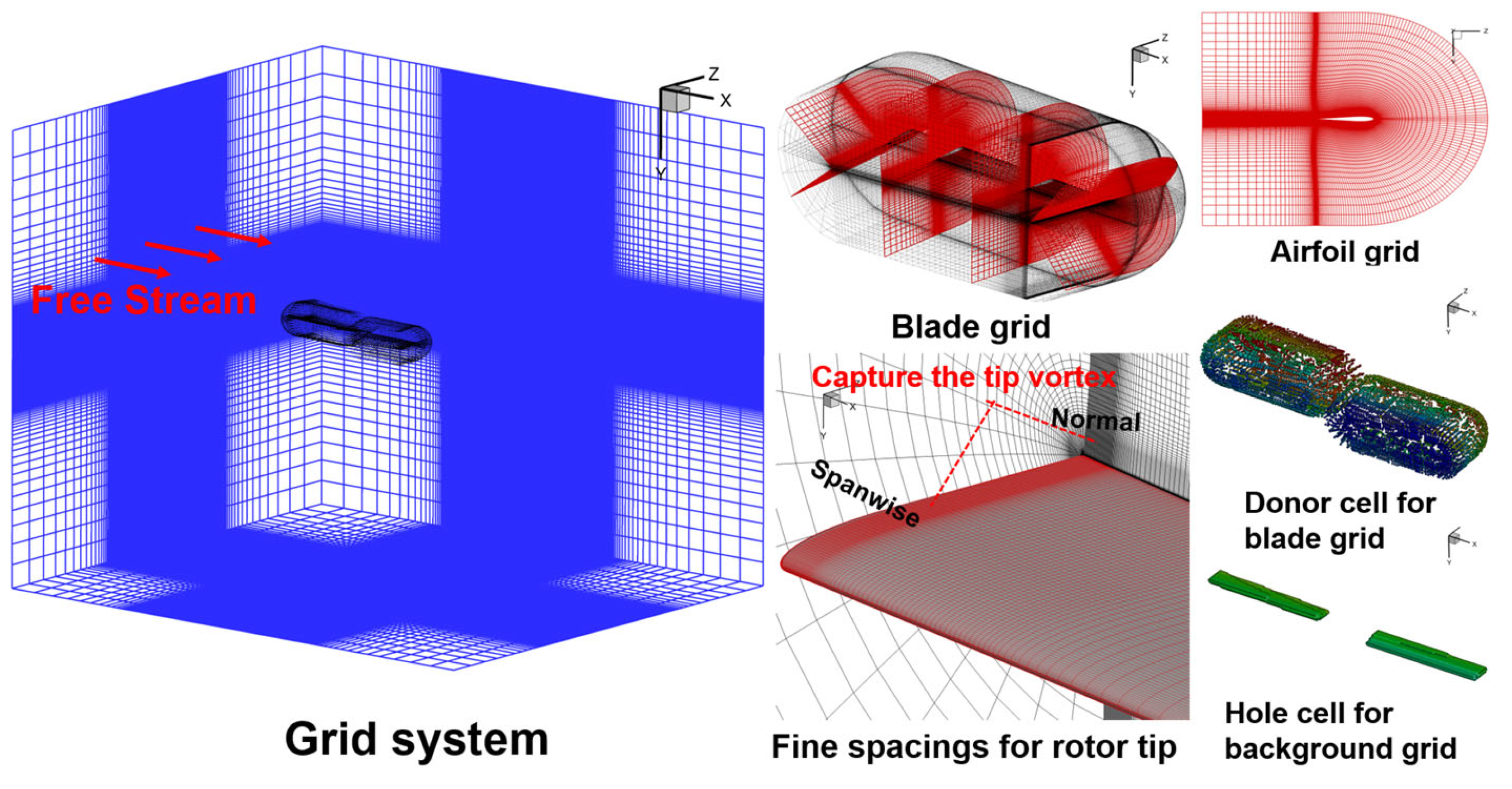
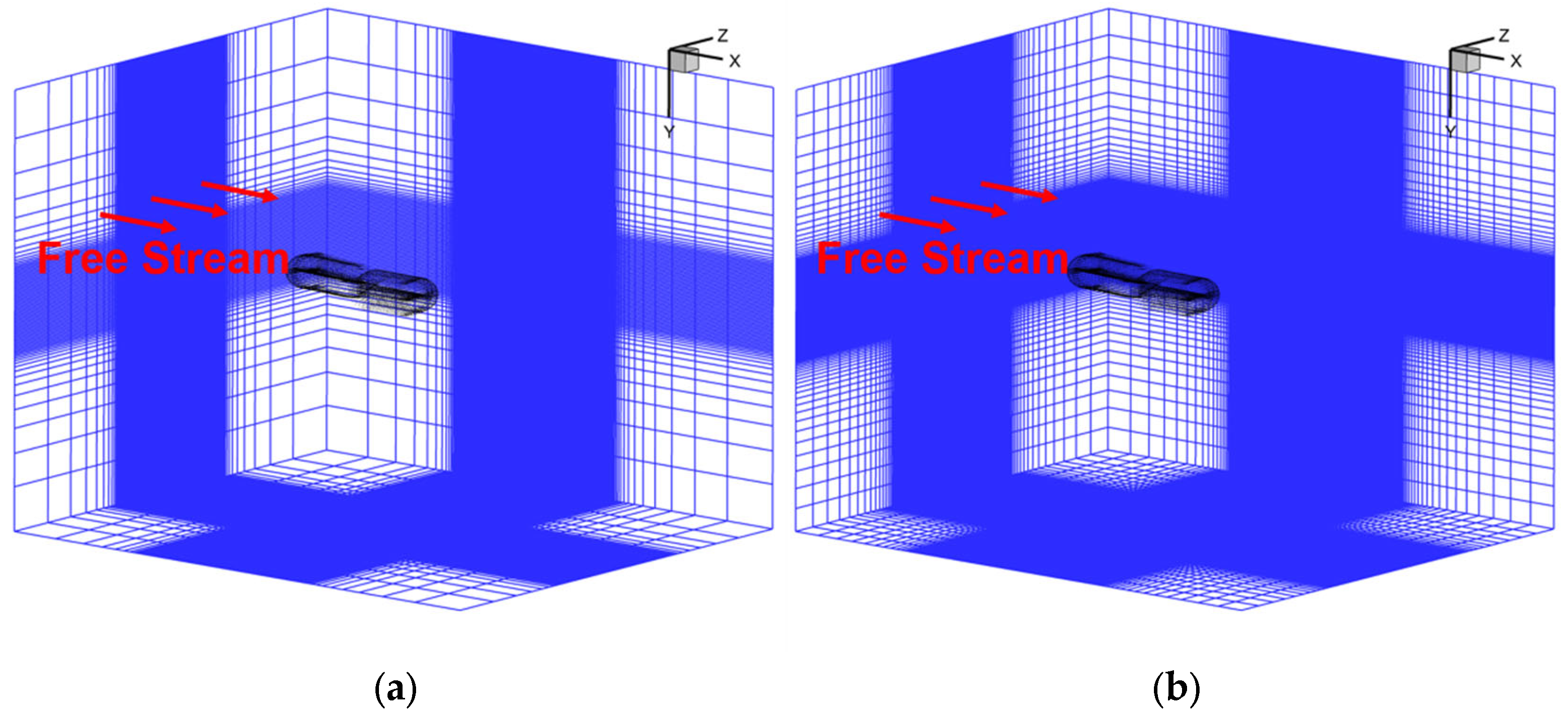

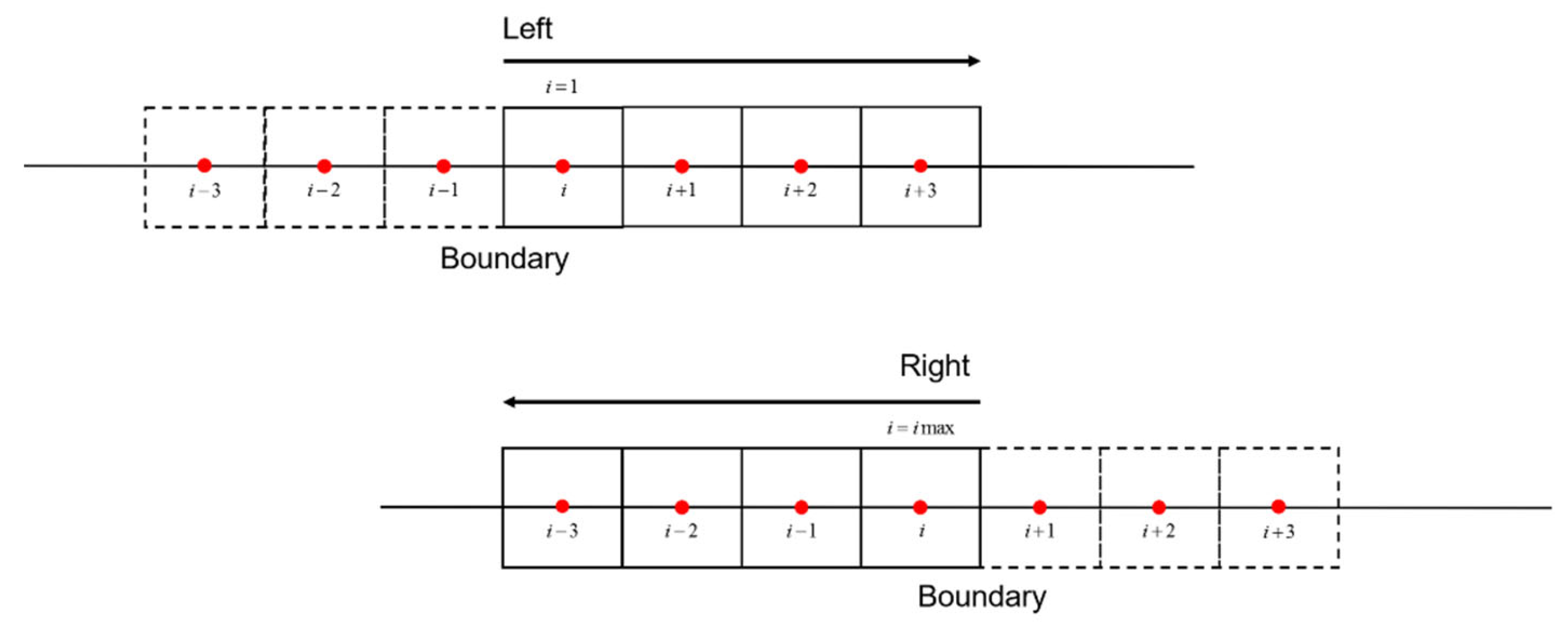
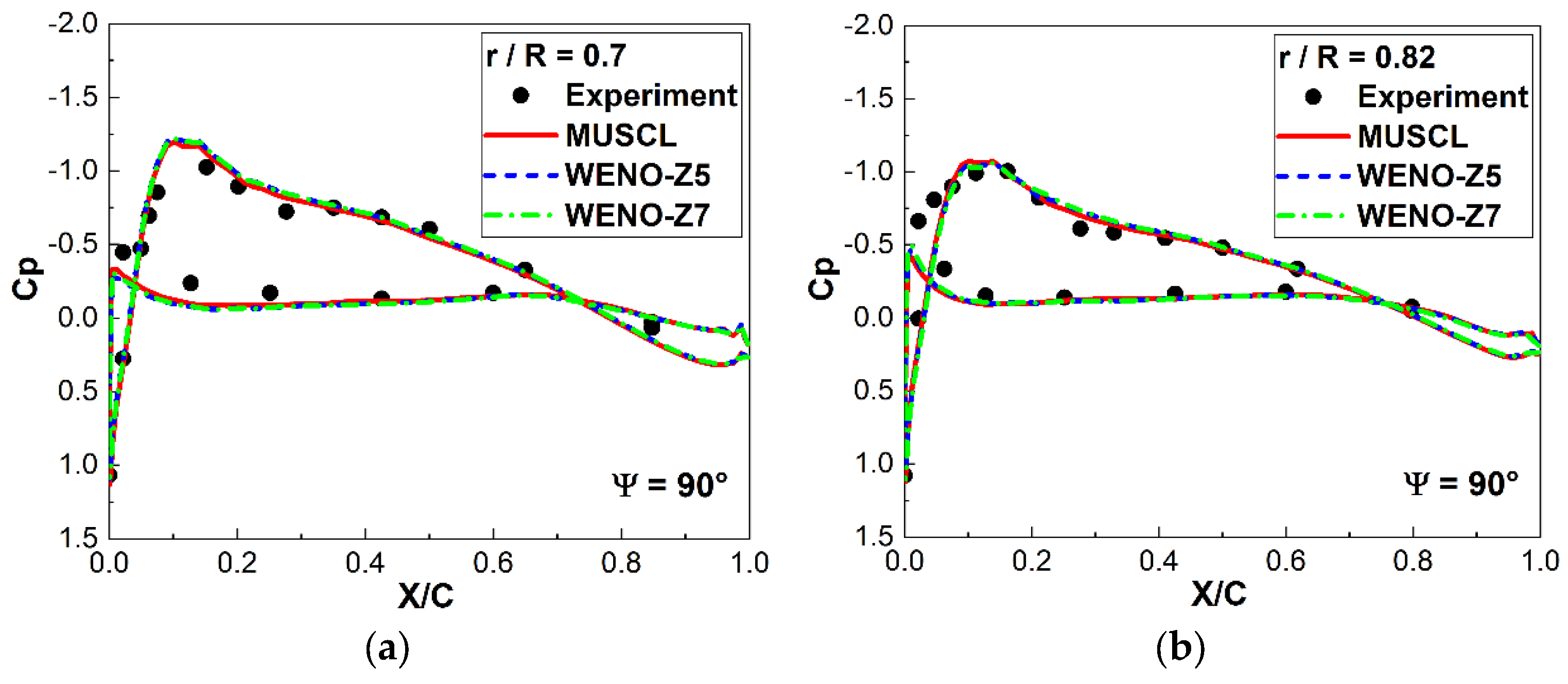
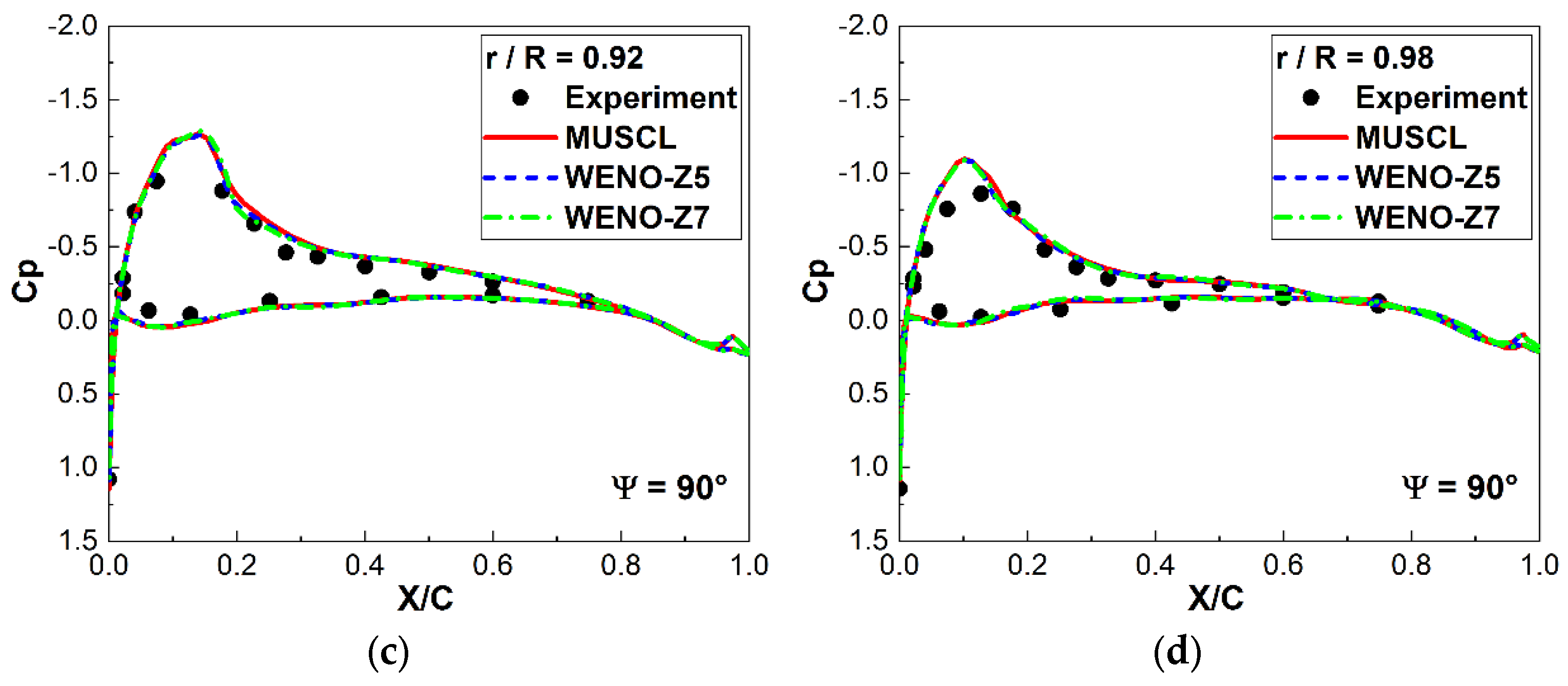
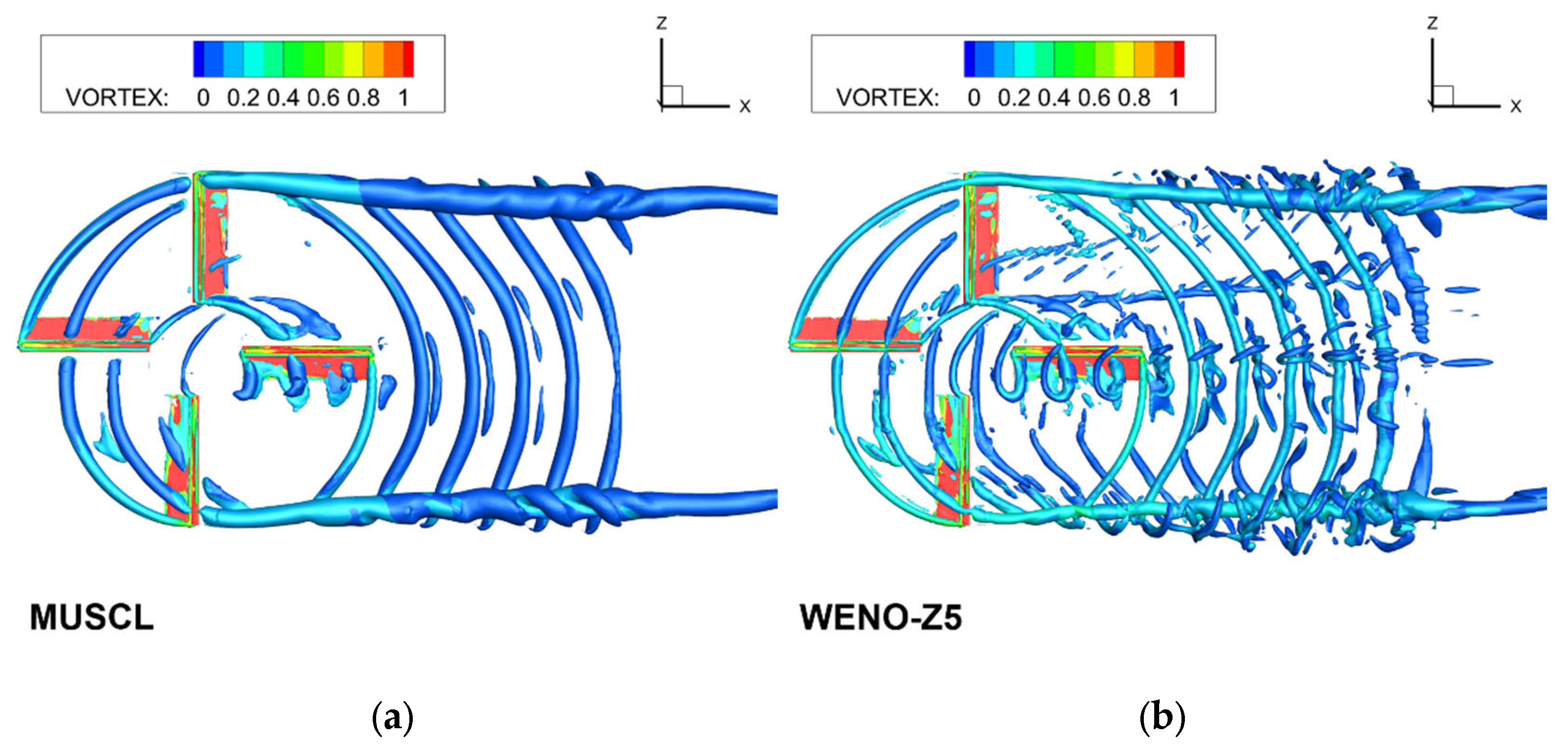
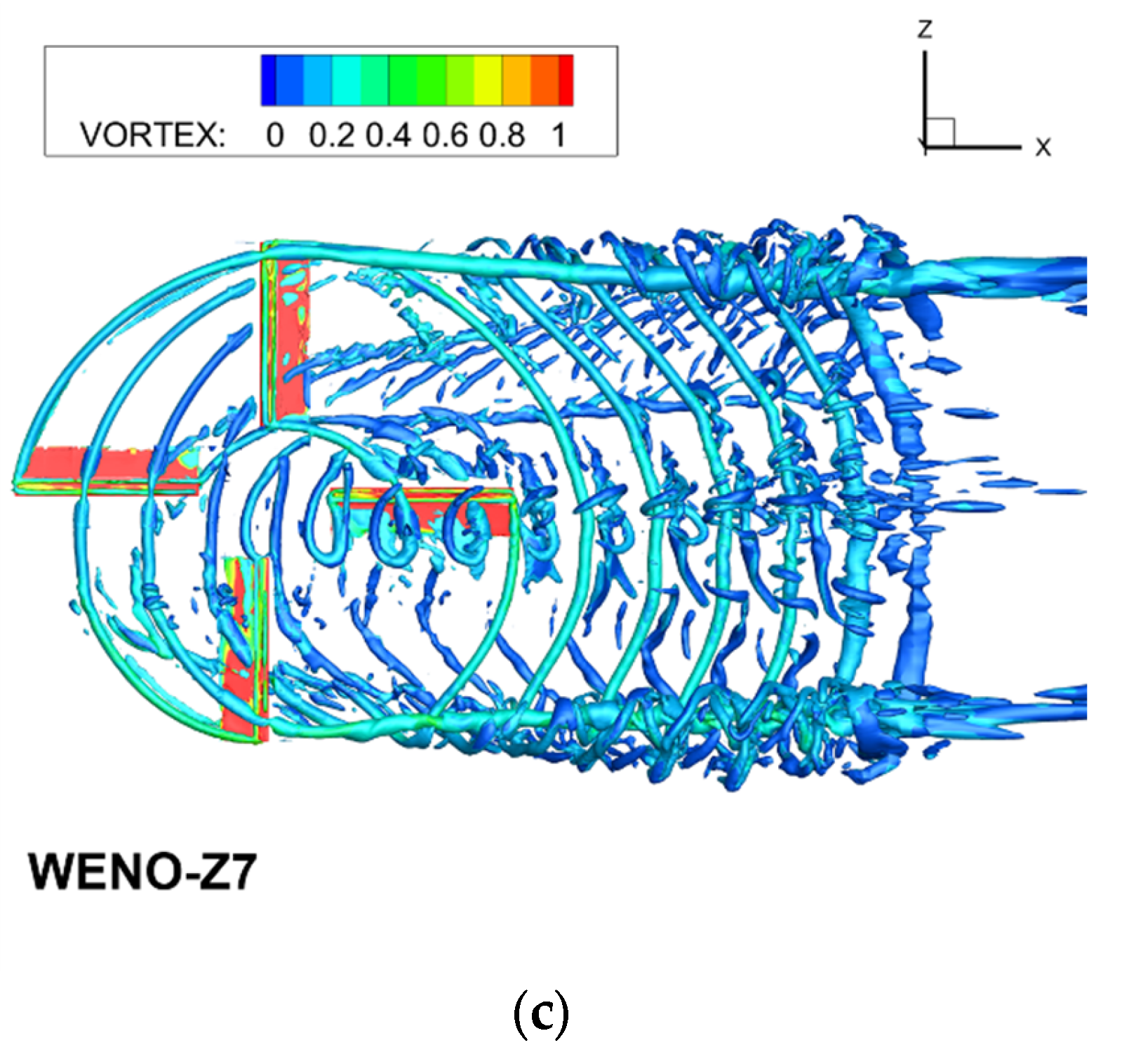
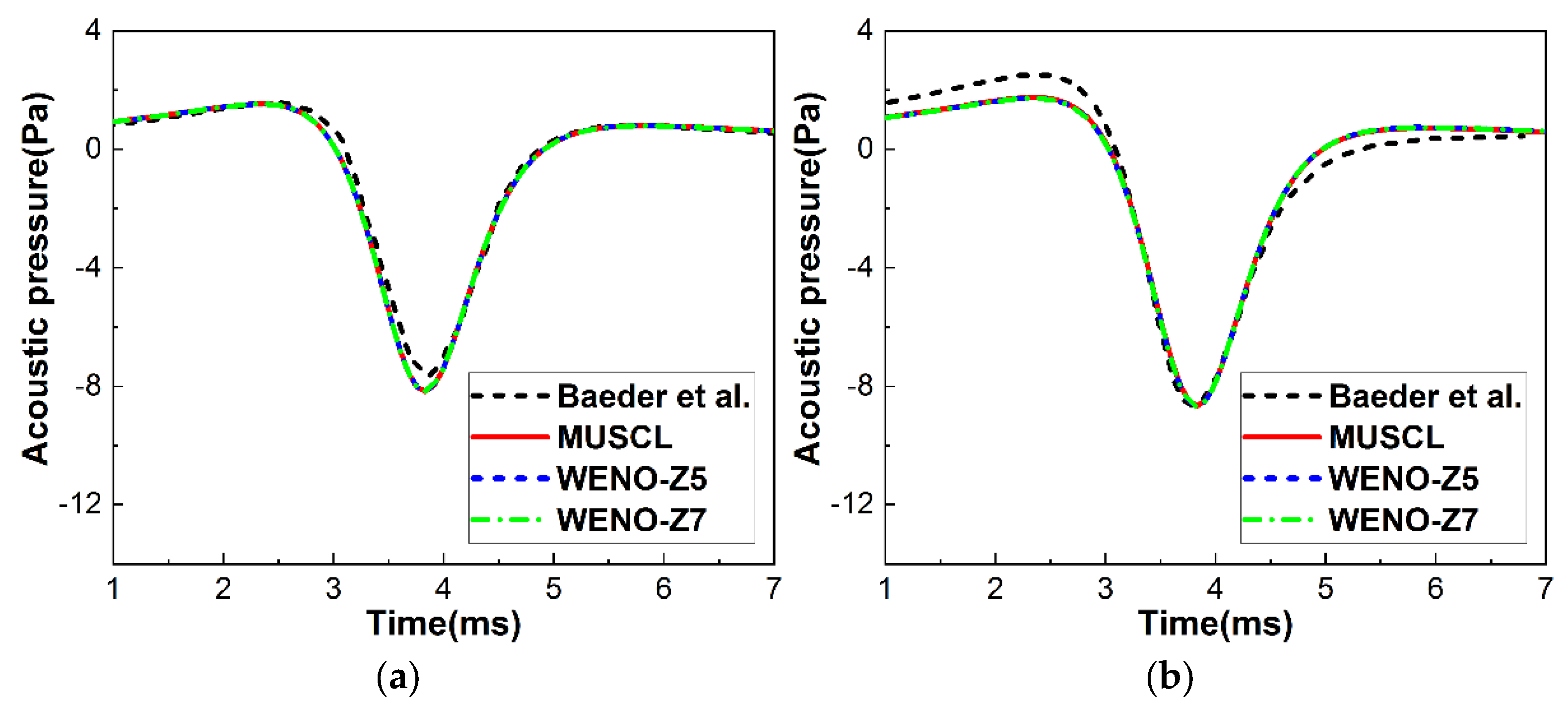
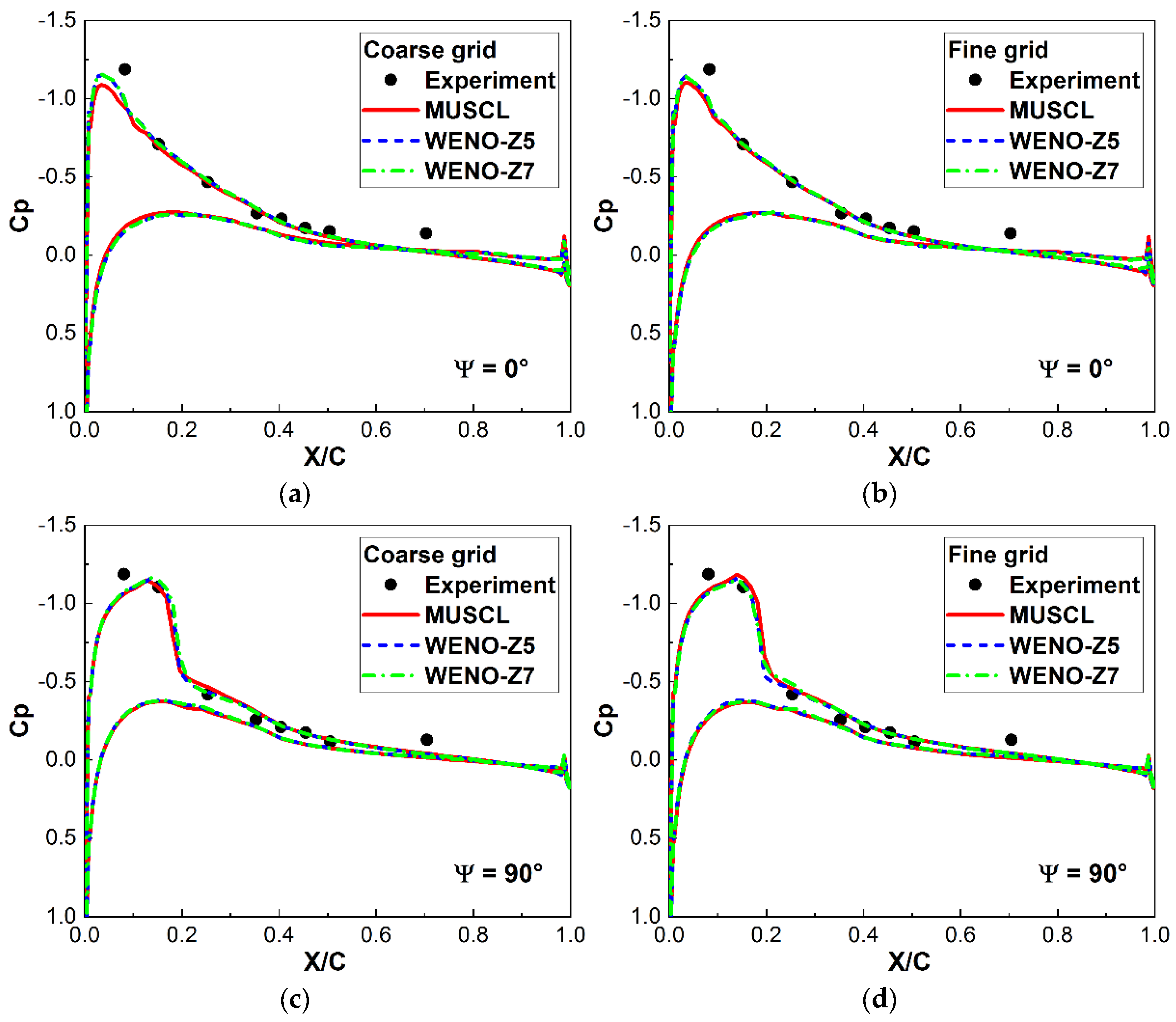
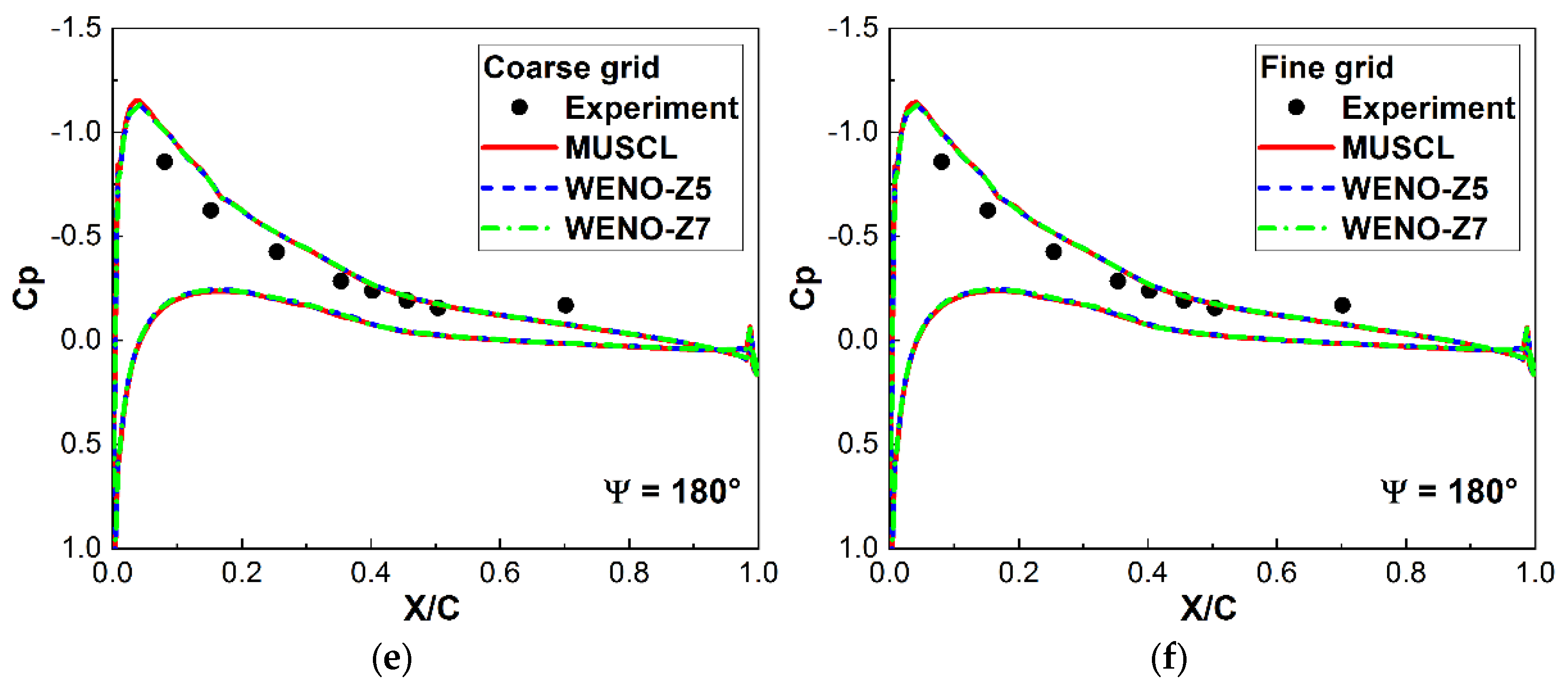
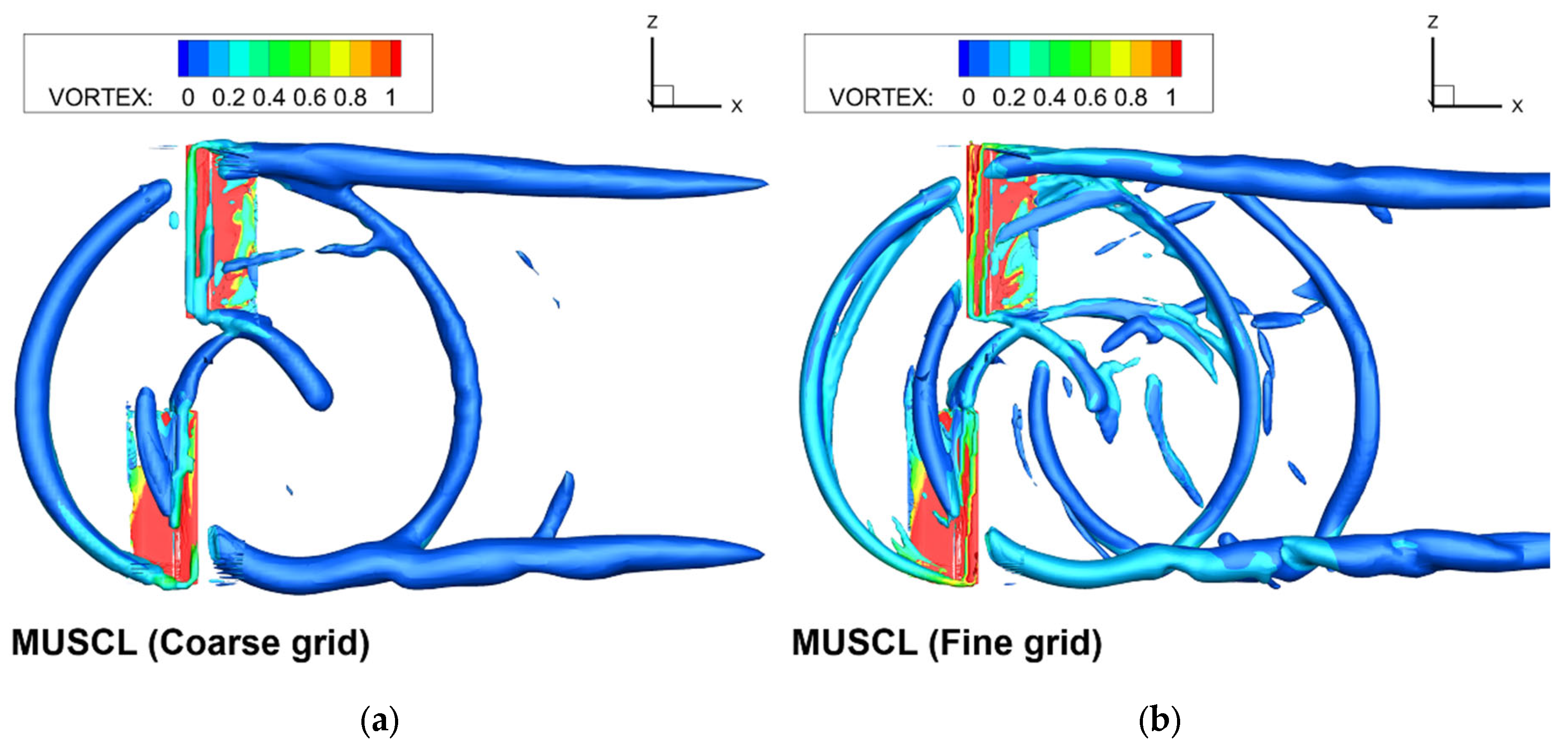
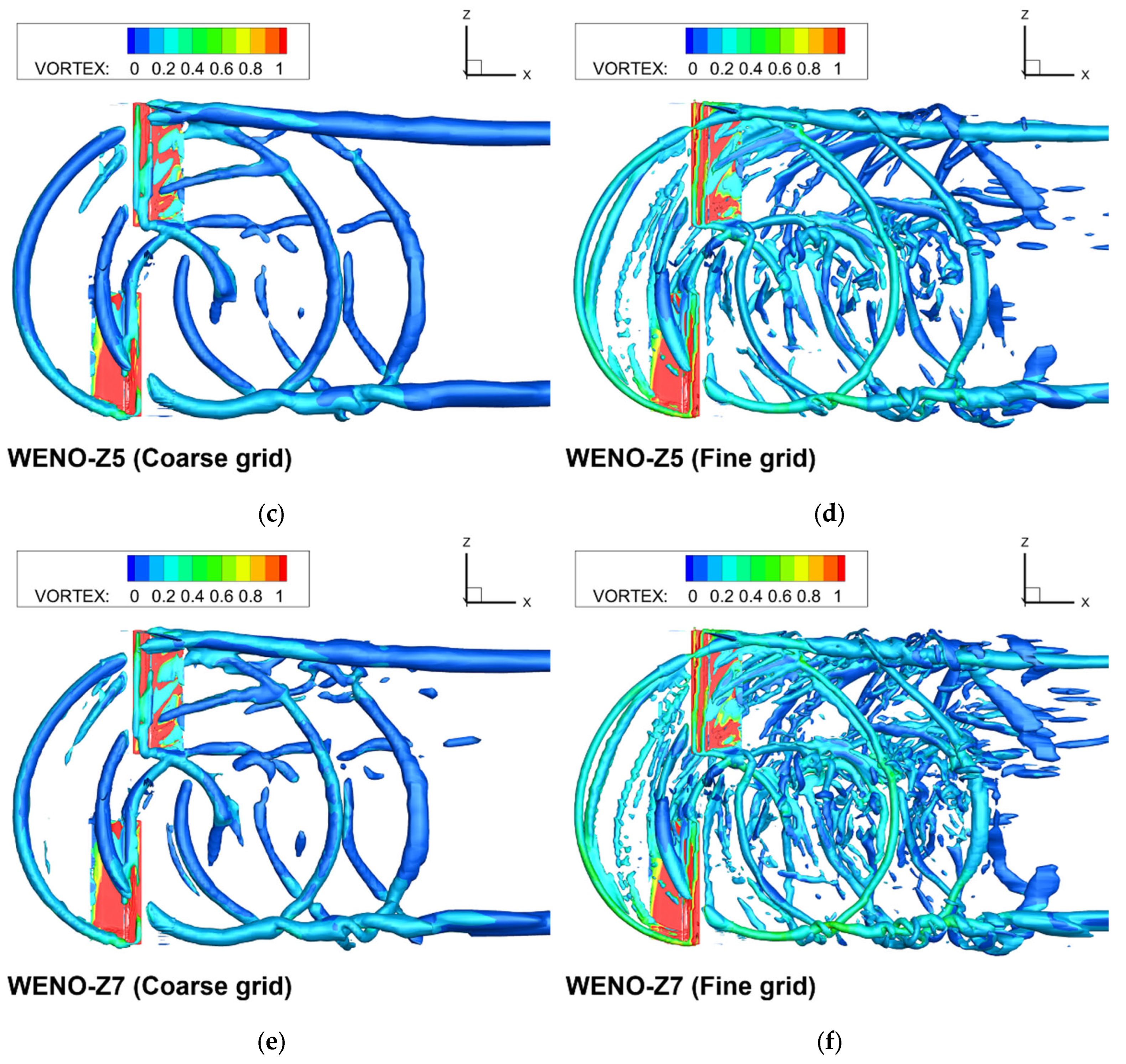
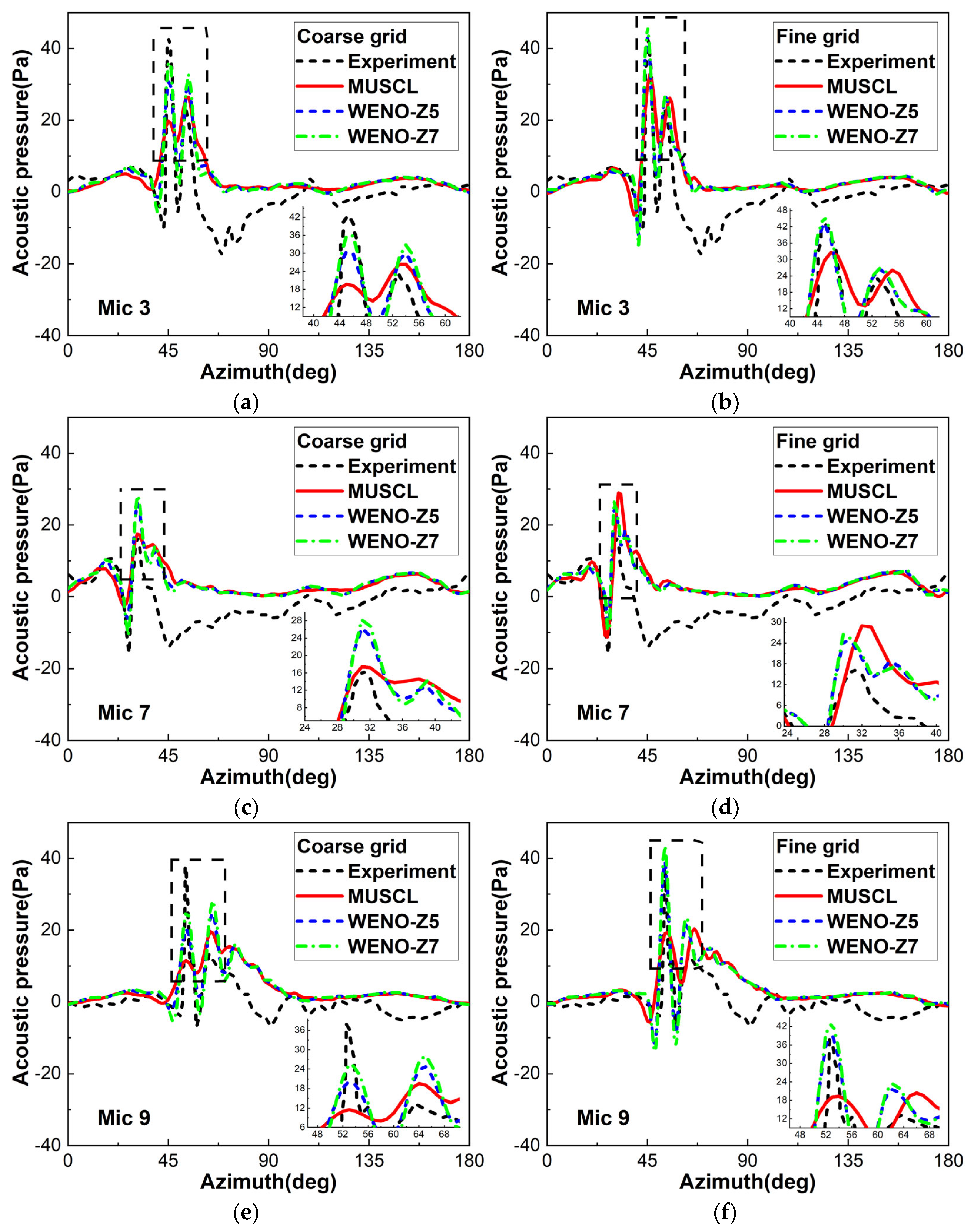
| Microphone | x | y | z |
|---|---|---|---|
| 3 | −27.467 | 15.858 | 0.0 |
| 7 | −23.787 | 15.858 | 13.733 |
| 9 | −23.787 | 15.858 | −13.733 |
| Case | Numerical Scheme | CPUh/rev | SPL (dB) | ||
|---|---|---|---|---|---|
| MIC 3 | MIC 7 | MIC 9 | |||
| Coarse grid | MUSCL | 150.2 | 108.414 | 105.344 | 107.705 |
| WENO-Z5 | 191.4 | 109.192 | 106.405 | 108.361 | |
| WENO-Z7 | 195.3 | 110.073 | 107.072 | 109.364 | |
| Fine grid | MUSCL | 333.1 | 109.816 | 107.786 | 108.434 |
| WENO-Z5 | 640.0 | 110.326 | 106.535 | 110.373 | |
| WENO-Z7 | 680.8 | 110.747 | 106.920 | 111.040 | |
Publisher’s Note: MDPI stays neutral with regard to jurisdictional claims in published maps and institutional affiliations. |
© 2022 by the authors. Licensee MDPI, Basel, Switzerland. This article is an open access article distributed under the terms and conditions of the Creative Commons Attribution (CC BY) license (https://creativecommons.org/licenses/by/4.0/).
Share and Cite
Sun, Y.; Shi, Y.; Xu, G. Application of High-Order WENO Scheme in the CFD/FW–H Method to Predict Helicopter Rotor Blade–Vortex Interaction Tonal Noise. Aerospace 2022, 9, 196. https://doi.org/10.3390/aerospace9040196
Sun Y, Shi Y, Xu G. Application of High-Order WENO Scheme in the CFD/FW–H Method to Predict Helicopter Rotor Blade–Vortex Interaction Tonal Noise. Aerospace. 2022; 9(4):196. https://doi.org/10.3390/aerospace9040196
Chicago/Turabian StyleSun, Yan, Yongjie Shi, and Guohua Xu. 2022. "Application of High-Order WENO Scheme in the CFD/FW–H Method to Predict Helicopter Rotor Blade–Vortex Interaction Tonal Noise" Aerospace 9, no. 4: 196. https://doi.org/10.3390/aerospace9040196
APA StyleSun, Y., Shi, Y., & Xu, G. (2022). Application of High-Order WENO Scheme in the CFD/FW–H Method to Predict Helicopter Rotor Blade–Vortex Interaction Tonal Noise. Aerospace, 9(4), 196. https://doi.org/10.3390/aerospace9040196






